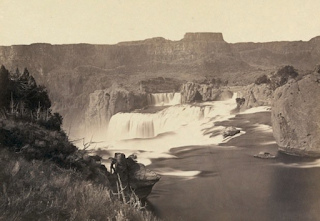Post Modernity
Post modernity (approx. 1940-2001+) comes from the idea that we have moved past the earlier ideas of modern era. It signifies an end to both religious and non-religious meta-narratives.
This is reflected in the world of art, and particularly photography. 'Post modern art' expresses a concern with 'representation and an ironic self-awareness' (Kirby, 2006).
In the early days of photography , the belief of western civilisation was still influenced by the church. things such as nature was captured very much in the style of oil paintings of that time, showing foreground,middle and background in an attempt to capture a feeling of depth and greater power. This belief, is a link from nature to the almighty power, is an example of a meta-narrative. A set of guidelines that society generally accepts and adheres to. The examples below show how early landscape photography was very receptive to the notion that there is a higher power, this is done using scale.
Especially in example too, the figure in the centre of the image is set against the vast expanse of yellow stone lake to show how just how small the human race is. Also, the mixture of misty mountains and poor print quality give the image a somewhat heavenly feel.
 |
|
O’Sullivan (1868) |
|
Ramos (2016) |
 |
| Gabriel (2016) |
Gabriel, M
(2016). How To Use Drones To Shoot
Stunning Aerial Photographs. Available at https://contrastly.com/how-to-use-drones-to-shoot-stunning-aerial-photographs
(accessed 4th October 2017)
Jackson, H (1871). Yellowstone’s Photo
Collection. Available at: https://www.nps.gov/features/yell/slidefile/history/jacksonphotos/page-1.htm
(accessed 4th October 2017)
(accessed 10th October 2017)
Kirby, A (2006). Philosophy Now: a magazine of ideas. Available at:
https://philosophynow.org/issues/58/The_Death_of_Postmodernism_And_Beyond
(accessed 9th October 2017)
O’Sullivan, T (1868). American west in pictures, 1860s – 1870s. Available at: https://rarehistoricalphotos.com/american-west-in-pictures/
(accessed 10th October 2017)
Ramos, J (2016). 7 Tips for Capturing More Powerful Fine Art Landscape Photography. Available at: https://petapixel.com/2016/09/27/7-tips-capturing-powerful-fine-art-landscape-photography/
(accessed 10th October 2017)


Comments
Post a Comment